
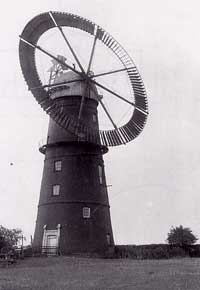
Ruffles Mill |
The History of
Haverhill
in the 20th Century
Pre
1900
|
Please click here to look back into Haverhill's history before 1900.
|
|
1900
|
The Recreation Ground was opened with great ceremony. It was a gift to the town from W.B. Gurteen to commemorate Queen Victoria's diamond Jubilee.
The silk weaving firm of Kipling and Co was taken over by Walters. Their silk factory at Hamlet Green was later closed.
A gruesome murder occurred in Keebles Yard when Elias Backler murdered his common law wife, Louisa Mizon, and her 22 days old twin sons.
|
|
1901
|
By the end of the nineteenth century Haverhill had almost come to resemble a red-brick midlands mill town, dominated by the Gurteen's Factory. Most of the people in Haverhill worked in some way for the Gurteen family.
|
|
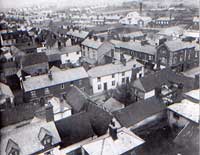
Peashill Slade
|
|
blank |
Houses were tightly crowded together as this view from St Mary's church tower in 1900 shows. There was much company housing, several non-conformist churches, a fine Town Hall (given to the community by the Gurteen family), a local newspaper and two railway stations, Haverhill South on the Colne Valley line, and Haverhill North on the Stour Valley line. Domestic architecture included a block of twelve houses known as Weaver's Row each of which had three storeys, the middle one containing the loom. Around the town were no fewer than three windmills, including the unique ring-shaped Ruffles Mill on Chalkstone Hill, which was pulled down during the Second World War.
The population of the town in 1901 was around 4,000, and Haverhill remained a small but active agricultural and industrial township.
|
|
1902
|
The Haverhill Industrial Co-op began to undertake a milk delivery round. This enterprise was to be very popular.
Much excitement was had when Biddle's Wild Beast Show came to Haverhill.
|
|
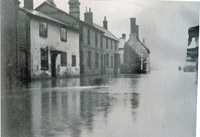
Queen Street floods 1903
|
|
1903
|
In June, following three days of extremely heavy rain, the river overflowed and large parts of the town suffered serious flooding, particularly Queen Street and Withersfield Road. At the Hamlet end the water reached the entrance to Atterton's foundry.
The rain had begun on mid day Saturday June 13th, continued all through Sunday and on into Monday the 15th. By leaving off time at the factory at 6pm on Monday 15th June, workers could not get home to Withersfield Road. The waters were at their peak at 9.30 pm, and had completely receded by 2 am next morning.
In the 27th June issue of the South West Suffolk Echo there was an advert which said, "The Great Flood at Haverhill. June 15th , 1903. Such a flood may not occur again in your lifetime. You should therefore, secure for yourself and your friends a souvenir of the event by purchasing some of the pictorial postcards shewing Queen Street and the Meadows under water. Price-One Penny each."
|
|
1904
|
A large part of Attertons works at Hamlet Green were destroyed by fire.
|
|
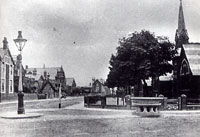
Horsetrough seen in 1916
|
|
blank |
In 1904 Lady Malcolm presented Haverhill with one of its features which had been thought lost for ever. This was the water trough which stood for years on the Cangle Junction, until it was removed for road junction improvements in the 1960's. In 1998 it would be returned to Haverhill.
The bells of St Mary's church were recast or restored, and a new bell added to bring it up to a minor ring of six. One of the re-cast bells had pre-dated the Great Haverhill fire of 1667.
|
|
1905
|
Women often led on issues in factories like Gurteens. A number walked out for a week at the end of February to get an extra 6d per dozen garments. This was on a government contract just won for making khaki uniforms.
|
|
1908
|
The Colne Valley locomotive repair sheds were moved from Haverhill South Station yard to Halstead.
There was a heavy fall of snow on Easter Monday, April 20th.
|
|
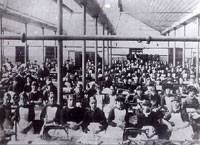
Gurteen's in 1900
|
|
1909
|
Gurteens installed the patent Henderson hair looms powered by their 1880 steam engine "Caroline" via belts and shafts.
Hair cloth made from horse hair was used to stiffen cloth for lapels etc and up to 1909 could only be made on hand looms.
The Gurteen family also erected a cricket pavilion for the town.
|
|
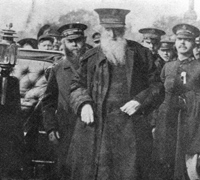
General Booth at Haverhill 1910
|
|
1910
|
General Booth visited Haverhill in 1910 to further the work of the Salvation Army. He must have been aged 80 or 81 at the time. He had trained as a Methodist minister, but left that church to pursue an evangelical mission. In 1865, Booth and his wife Catherine opened The Christian Revival Society in the East End of London. In 1878 the name of the organization was changed to The Salvation Army.
|
|
1911
|
By 1911, the population was 4,749.
Haverhill's first cinema seems to have opened in 1911 in the garden of a house in Chauntry Road. It was called the Premier Picture Palace.
|
|
1912
|
The Haverhill Electric Palace was opened in the alley off the High Street, where the motor cycle shop now stands, at the rear of 39 High Street. Later it became called The Empire Cinema. Barclay's Bank now occupies Dr Goodman's house at number 39. Military manoeuvres
took place at Hundon and Horseheath. King George V passed through Haverhill on his way to see them. Factories like Gurteens shut up shop for the day, and everybody turned out to cheer the king and watch the soldiers.
Haverhill Women held a Suffrage Meeting on Market Hill to support the call for Votes for Women. After half an hour a local element of rowdy youths broke up the meeting.
|
|
1914
|
By 1914, the population of Haverhill was 4,900. The town had grown from 1,200 in 1800, slowly at first, with most growth in the later part of the 19th century. A decline probably set in between 1901 and 1911.
However with the outbreak of war, Gurteens received new government contracts for the supply of military uniforms. They had done some government work since 1905.
|
|
1915
|
Taylor's Flour Mill in the Pightle was sold to The Hovis Bread and Flour Company.
|
|
1916
|
There was a large airship raid of eight Zeppelins on the night of 31st July and 1st August, 1916. Bad fog caused the attack to be a failure, but one airship, the L22, overflew Haverhill. Luckily it failed to attack the town.
Another large attack on the 2nd / 3rd of September which was intended to attack London got lost due to bad weather and failed navigation. The German navy had sent 11 Zeppelin airships and the army sent 3 more. In the confusion, airship L30 bombed Bungay. One of the army Zeppelins, the LZ90, then attacked Haverhill.
In 1916 the Government declared that the road from Bury St Edmunds to Haverhill was "of military importance". However, it needed extensive repairs, and with most men being in the armed forces, there was a shortage of labour. The Road Board decided that about 150 conscientious objectors should be put on to the project, and needed somewhere to billet them. They asked the Risbridge Board of Guardians if they could be housed in the Kedington Workhouse. This workhouse had often been half empty, and had survived by taking in paupers from other Board areas, as far afield as Birmingham, Lambeth and Mile End.
The Guardians and the local people had no time for conscientious objectors, and did nothing to help them. They locked the place up at 9pm, and insisted on enforcing the Workhouse rule on them. This led to trouble in October, and 11 men deliberately stayed out all night. Leaflets and slogans were distributed in support of socialism and the Independent Labour Party.
By January of 1917, the repairs were finished and the men left, leaving the Road Board to pay £13 in damages to the Guardians for deliberate breakages left behind.
|
|
1917
|
The winter of 1916 and 1917 was severe and prolonged.
In February the gas system failed in Haverhill and the town was in darkness for several days.
In June there was an extremely violent localised storm in Haverhill. A house in Withersfield Road was struck by lightening.
In August the Kedington Workhouse became home to a number of German prisoners of war who were drafted in to help with the harvest. They were reported to be less trouble than the 150 conscientious objectors who were there the year before.
|
|
1918
|
The Brewers Greene King of Bury St Edmunds bought up Mr Christmas' Haverhill Brewery. His name is occasionally remembered with a brewing of Christmas' Ale, which celebrates him rather than the festival.
|
|
1919
|
Haverhill Ex-Servicemen's Club was set up using money from the United Services Fund.
|
|
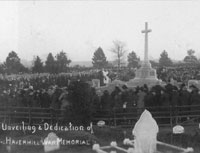
Haverhill's war memorial
|
|
1920
|
On 21st November, 1920, the war memorial at Haverhill was dedicated and unveiled. It was unveiled in front of a very large crowd by Lt General Sir Charles Briggs. The memorial was in the form of a cross in stone, placed upon a substantial pedestal, around which were engraved 144 names of Haverhill's war dead. (A few of these names were added at a later date.) The memorial was located within Haverhill's cemetery, which itself was opened in 1867.
The local British Legion branch was formed to aid war-wounded, widows and ex-servicemen.
Gurteen's organised the biggest works trip ever seen in Haverhill when they took two special trains to the Empire Exhibition at Wembley.
The Haverhill Secondary School was opened using the West End Congregational Church's Sunday school building.
The Haverhill Rope Works replaced their old open sided rope walk by a new wooden shed. This new shed is now located at the Museum of Rural Life at Stowmarket.
Haverhill had had a Brass Band since the early 19th century. But in 1920 the Haverhill Co-operative Silver Band was formed.
At some point in the 1920s Haywards Garage was set up to service cars as the business changed over from being wheelwrights and carriage builders. By 1931 they were main Ford Dealers, the sort of change happening all over the country.
Tommy Turner's Dance Band dominated social events in the 1920's and 30's.
|
|
1921
|
The Co-Op building was extended to provide a provision department. Haverhill's first ten council houses were built in Wratting Road by the Haverhill Urban District Council.
|
|
1923
|
Brewing ceased in Haverhill late in 1923 when Greene King shut down their Haverhill operations. A sharp recession had led to a fall in sales and the needs of Haverhill could be met by lorry from Bury. Some of the workforce moved to the Westgate Street premises of Greene King in Bury St Edmunds, travelling up to 40 miles a day.
A swimming bath was opened at the Burton End waterworks, but the water was not kept as it should be.
The London and North Eastern Railway took over the Colne Valley and Halstead Railway.
|
|
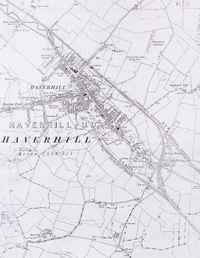
Map of Haverhill 1925
|
|
1924
|
Haverhill South railway station in Colne Valley Road was closed to passengers following the LNER take over. However, the goods service remained until 1961.
|
|
1925
|
At Gurteen's Chauntry Mill a Lancashire Boiler was installed to power the mill.
|
|
1927
|
John Atterton took in William Ellis as a partner and the firm became Atterton and Ellis. Atterton was to die in 1929 at the age of 91. Council housing was not a large enterprise before this date. The Haverhill UDC owned just 10 properties, built in Wratting Road, but new housing was now planned.
|
|
1928
|
A second cinema came to Haverhill when The Playhouse was built on the High Street in the garden of Chauntry House. Haverhill then had two cinemas until 1954. The Playhouse site itself probably held a Chauntry Chapel in Medieval times.
|
|
1929
|
Haverhill Co-op was doing so well that it opened a branch in Clare.
Gurteens became the limited company of D Gurteen and Sons, but apart from this its production through the 1930's remained very similar in style to the 1920's which was mainly heavy jackets and trousers.
|
|
1930
|
Electric light now came to Haverhill, and work began on the swimming bath.
|
|
1931
|
A new open air swimming bath was opened off Swan Lane with clear water and diving boards. It replaced the poorly maintained baths at the Burton End Waterworks. The new site was next to the Town Yard or Council Depot, and the new Council Offices and new public conveniences were in front.
Swan Lane also got a new bridge over the Stour Brook.
From 1921 to 1931, Haverhill's population fell by 255 persons from 4,083 to 3,828.
|
|
1933
|
Gurteen's front office was demolished to make way for the post office. Their offices were moved into Chauntry Mill, perhaps a symptom of the firm struggling in these years.
|
|
1935
|
Haverhill Rovers launched an appeal to raise £250 to build a grandstand to provide spectators with cover.
The silk mills finally closed in Haverhill. This helped to increase movement of people out of Haverhill at this time. By 1939 it was estimated that the population was down to 3,714.
|
|
1936
|
The new Hovis Flour Mill was completed as a total rebuild of the old existing Hovis mill, originally built in the 1870's by Fred Taylor. The steam engine was replaced by diesel. The Garrett's steam engine replaced by Hovis still survives in the place where it was built - The Long Shop Museum at Leiston in East Suffolk.
The Co-op built a new dairy with an up to date pasteurisation unit.
By 1936 the Haverhill UDC had twelve new houses either just completed or in progress. The Council planned to build 16 houses in Mill Hill and Clements Lane. When completed, the H.U.D.C would have built 141 dwellings, all but 10 built since 1927.
Seventy six new houses were also approved for the Bradford Property Trust to be built in Helions Wood, with an extension to Recreation Road.
Traffic congestion, particularly in Queen Street was a problem even in 1936. Councillors were convinced that there was ample parking on Market Hill within 200 yards from any shop they may wish to visit, and that nobody need park in Queen Street. Another idea was 15 minute limited parking on one side only of that notoriously narrow street. In these days the name Market Hill referred to the wider part of the High Street, not the Peas Market Hill of today.
|
|
1937
|
The Helions Park Estate was built for speculative owner occupation in what were then the new compact suburban styles.
The swimming bath gained a chlorination and filtration plant.
|
|
1938
|
The Haverhill and Kedington Scouts created the Air Scouts with the help of the base at Stradishall aerodrome.
Air raid precautions volunteers met in the Council School (at Cangle Junction), and their training was stepped up after the September Munich crisis. Shelter trenches were dug in the Recreation Ground.
The Roman Catholic church was erected in a temporary wooden structure dedicated to St Felix in Withersfield Road.
|
|
1939
|
Between the two world wars the town had been hit by the economic depression and the population once more declined, standing at under 4,000 on the eve of the war in 1939. By 1939 it was estimated that the population was down to 3,714 from 4,083 in 1921. In this period the brewery had closed, the silk mills closed and several brick works had failed. The textile industry of Gurteens increasingly employed women, and agriculture also suffered a depression. Men had to either find new work outside Haverhill, or move away entirely. Haverhill would enter the Second World War in a perilous economic position.
In February, gas masks were issued to all the population. In May the Haverhill Company of the 5th Battalion (Territorials) Suffolk Regiment was re-formed. In August a large ARP exercise was held overnight and on 1st September all street lighting was switched off and blackout conditions imposed. War was declared on 3rd September, and four ARP warden posts were soon set up. Number 1 was a concrete shelter at the south east corner of the Rec. Number 2 was in a yard behind the school in Wratting Road, and number 3 was at Baldocks Garages in Withersfield Road. Number 4 was a room in the Town Hall in the High Street. The Observer Corps post, first set up in the Downs in 1930 was now manned 24 hours a day.
Haverhill was considered a "safe" area for evacuees and 180 children were soon to arrive from Page Green School in Tottenham. The old Ruffles windmill in Wratting Road was partly demolished because its distinctive circular sail was deemed to be an excellent landmark for enemy aircraft. In October, the Haverhill Rovers Supporters Club converted itself into the war Charities Club for the duration of the armed conflict.
The Haverhill ex-servicemen's Club premises built in 1934 in Quakers Lane were given over to the various military units in the area for the duration of the war. Meanwhile the Club returned to its pre-1934 premises in Queens Place, off Queen Street, until 1945. The Club is still thriving in 1999.
Other consequences of war were that civilians were often relieved of their property for war work. For example, at Clare Priory, now a private home, Lady May, a descendant of the Barnadiston line, had to leave home. The Priory was commandeered by the army for a Brigade Headquarters for the duration of the war.
Ironically, Haverhill's public tennis courts were also opened in 1939.
|
|
1940
|
January had severe wintry conditions with snowdrifts blocking roads and railways. The War Charities Club began running dances in the Town Hall, with reduced admission prices for men in uniform. The Town was becoming a garrison with many town premises being used by the army. The London Irish Rifles were particular favourites in Haverhill. Hamlet Croft had several Nissan huts built on it. The Queens' Bays provided a dance band for Saturdays but also parked their Bren Gun Carrier Tanks at Place Farm. The Kings Own Scottish Borderers and the Highland Light Infantry were also billeted locally.
In May, Mr Anthony Eden announced the setting up of the Local Defence Volunteers. By July the name was changed to the Home Guard and Haverhill soon had three platoons.
The Haverhill Territorials had been the nucleus of the 58th Medium Regiment Royal Artillery and spent four days on Dunkirk beach before being rescued by HMS Kellett. Evacuated troops camped at Wilsey Meadows.
Castle Camps had a grass landing ground and dog-fights
were visible daily high in the distance during the Battle of Britain. Anderson shelters were built in gardens at the householder's expense, except for those on less than £250 a year, who got a Council grant.
On June 25th a bomb fell in Chapel Street at Steeple Bumpstead damaging the Congregational Church windows. In August two bombs fell harmlessly at Pale Green, Helions Bumpstead. A few other bombs were dropped in the vicinity with only slight damage resulting.
Unfortunately more deaths resulted from road accidents during the blackout and by collisions with army vehicles than from enemy action. Not so for the local airmen; many of the fighter pilots from Castle Camps were lost, sometimes crashing locally.
Many railings, chains and ornamental ironwork were taken down for war salvage.
In October, 250 more evacuees came to Haverhill, although a few of the original Tottenham children trickled home by the end of the year.
Four public air raid shelters were built in Haverhill, one near to the Playhouse cinema, but it was very dark and damp. The Bull public house cellars were opened to residents of Peas Hill. Some time around
1940 the West Suffolk County Council closed the secondary school, moving the pupils to school at Sudbury.
Vitovis Ltd took over the premises of the Haverhill Steam Flour Mills in the Pightle.
|
|
1941
|
Fire watching units were set up following a broadcast by Herbert Morrison, the Home Secretary. The first unit in Haverhill covered Mount Road and Meetings Walk. More bombs fell around Haverhill with little damage, but aircraft crashes became more regular. A Stradishall plane fell at West Wratting, killing all its crew. A Hampden crashed near Ann Sucklings Lane.
In March, Haverhill Air Training Corps were formed with three flights, Haverhill, Clare and Linton, all part of 451 Squadron.
A searchlight unit at Hanchett End was attacked by an enemy plane. Later it moved to Horseheath where the unit helped rescue the crew of a crashed Stirling bomber from Wratting Common.
Another victim of the blackout came at Sturmer railway station when an elderly man from London was drowned in the river, having alighted from the train on the wrong side.
The Haverhill Fighter Aircraft Fund was supported by the Haverhill Dramatic Players productions, and £1,500 was collected by May. Also in March, a Dornier bomber strafed the High Street area with machine gun fire from
the Queen Street end down to the Old Independent church. Luckily nobody was hurt. Castle Camps had a very successful War Weapons Week in May and raised £7,000, and Haverhill held a similar week in July. Processions, events and displays and sports events raised £163,000. In December the Haverhill British Restaurant was officially opened in the Town Hall. On 7th December the Japanese attacked Pearl Harbour and America joined the war.
|
|
1942
|
The Haverhill firm of Atterton and Ellis were taken over by Boardmans of Sturmer, "young" William Ellis having died in 1941. Their grinding machines were still sold in 1999 into Europe and the USA.
The best show seen in Haverhill for some years was put on by the concert party of the London Irish Rifles in January.
Local services started to suffer. The Co-Op halved its bread delivery days to just three a week. Magazines were in short supply and the South West Suffolk Echo was reduced in size. Blackout and military accidents continued.
Warship Week raised £43,000, and the town adopted MTB Number 227. The railway stations were constantly busy with service movements particularly for the local RAF stations. Weekend concerts and dances arranged at the Town Hall by the Haverhill War Charity Club were packed out.
The secret new plane, the Mosquito, was tested at Castle Camps by 157 Squadron, and in May one crashed at Helions Bumpstead.
The London Irish Rifles were moved out of Haverhill and replaced by the King's Royal Rifles.
By June the rationing was extended to even more items, and blankets and sheets were only available to newly-weds. The existing air-raid shelters were kept locked as they were thought to be too dangerous to use. A new shelter was to be built for 50 people in Swan Lane.
There was continued restrictions of services at home and constant news of relatives killed or Missing in Action. Haverhills' Prisoners of War Week was held in December.
|
|
1943
|
By 1943 the 70th Battalion Hampshire Regiment had moved into the Haverhill area. News was also arriving of the fate of many local men captured at the fall of Singapore. In February the old links with America were renewed when a US army officer from Haverhill , Massachusetts, visited the town.
In March, MTB Number 227 was formally adopted once enough money was raised.
In April, "Wings for Victory" Week was held in Haverhill and £50,000 was raised, enough for two Mosquito fighter-bombers.
The first Americans were now based at Ridgewell airfield and visits were also arranged for Bob Hope, Edward G Robinson and Glen Miller. Fruit like bananas, lemons and grapefruit were so rare, that if any did appear they could be auctioned for charity or put on display. Ruffles Mill was being finally demolished in 1943, and a stone jar was found embedded in the brickwork. It contained a 1794 token and around its outer edge was inscribed the words"Payable at John Finchams Suffolk". The faces included the motto "Pro Bono Publico" and a handloom with the words "Haverhill Manufacturers".
The Haverhill Methodist Church held a special hour after normal services to meet black American troops and their Methodist minister from Youngston, Philadelphia. A black regiment was billeted for a time at Shudy Camps and the white American troopers objected to this, sometimes with violence. A black man was shot dead outside the Rose Tavern at Burton End.
In November, 350 men of the 8th Army were given a welcome "do" and later 80 officers of the Regiment were treated to a dinner.
|
|
1944
|
The Durham Light Infantry was now billeted around Haverhill, and as usual, joined in the town's social functions. A fire broke out in the Co-Op in the garage in Swan Lane, but as the fire station was opposite, the fire was soon put out.
As the 8th Army were still in town, General Montgomery visited them and drove down the High Street. Other famous visitors included the Duchess of Gloucester. The Duke of Kent visited RAF Castle Camps and King George VI came to RAF Stradishall. Rats were a problem, and people were urged to become "Rat Reporters".
A meeting was held in the Council School to launch a Haverhill branch of the Young Farmers Club. Welcome Clubs were set up around the country, including Haverhill to look after visiting soldiers. In May came "Salute the Soldier" Week. ARP exercises continued with many locals playing the part of injured civilians. RAF Castle Camps was attacked by an enemy bomber, and three bombs narrowly missed Helions Bumpstead. The plane was shot down near Ipswich. American fighters were often overhead from RAF Debden. One crashed at Little Smith Green, one pilot parachuted out and landed in the Police Station yard along the Pightle.
In summer 1944 there was a massive movement of bombs and supplies by rail to airbases at Birdbrook, Halstead, White Colne and Earls Colne. Special trains rumbled through Haverhill night after night.
In June the allotment land at The Downs was put up for sale but failed to reach its reserve price. But it became clear when D-Day was announced on June 6th what all the local activity among the troops had been about. Next day the first V1 Flying Bomb, or Doodle-bug, landed in Kent and 8,000 more were sent in the next six weeks. A few were seen over Haverhill, and one landed near Castle Lane. The first V2 Rocket exploded in London on September 8th 1944, but none were seen near Haverhill.
These attacks led to 50 more evacuees arriving from London. Hundreds of gliders were seen over Burton End heading for Arnhem.
August saw "Holiday at Home Week", and the street lighting was allowed to run at 2% capacity, better than complete blackout.
The Haverhill Co-Op Society celebrated its centenary in 1944. As the war was improving for Britain, the Newmarket and Thurlow Fox Hounds started up again at the Bradley Fox. In October, the crew of MTB 227 visited Haverhill and turned out to be sailors of the Free French Forces.
Haverhill UDC were already looking to expand the town and held meetings with the Haverhill Allotment Holder's Association about taking the Mill Field Allotments for housing. Oak Cottage and the Rookery Allotments were marked for industrial use.
In December, the Home Guard were stood down, but news was still arriving of local men lost in action, and news also of conditions in Japanese POW camps. The Haverhill Homecoming Fund was set up in anticipation of welcoming returning soldiers, sailors and airmen.
|
|
1945
|
Although the end of the war was in sight, all the old restrictions were still in force. The winter was particularly cold, and frost and ice caused many accidents. The Homecoming Fund had a good start but lost momentum as so many Haverhill men were still in Japanese hands. In February, the Haverhill Civil Defence Social club shut itself down, putting its £18 balance into the Homecoming Fund.
At Easter, a football match at Hamlet Croft between the RAF and the Army XI was followed by a display of horsemanship by the Don Cossacks from Russia. Over 1,300 spectators crowded in to see them.
One of the first POW's to return home had escaped from the Germans after capture in Africa. Castle Camps had a Polish Squadron in residence for a short time in the Winter and they staged an exhibition at the airfield for local people.
On May 8th, VE Day was declared, but local people already
knew the European War was over. Celebrations were overshadowed by the continued Japanese imprisonment of most local men, but Fire Guard Orders were cancelled and equipment auctioned off. Public Shelters were locked up, and weather forecasts were resumed by the BBC. A Children's Victory Tea was held in the Town Hall and 500 attended, followed by sports and entertainments.
More German POW's were returning, but none from the Far East. People had high hopes for the future but these were dampened by the news that new Ration Books would be issued for the next period of two years. Celebrations, fetes, fun fairs and circuses were held throughout the summer.
The Co-operative Building Society tried to buy 60 acres of Place Farm from West Suffolk County Council's Agricultural committee for 500 homes, but the County Council refused to sell. Instead they sold one acre at Burton End to Haverhill UDC for pre-fabs near to Primrose Hill.
The Haverhill UDC had a majority of Independent members and the MP for Haverhill South was a Conservative, Colonel Burton who had been MP for 21 years. Winston Churchill had headed the war time government, and was a Conservative as well, but at the General Election on 25th July 1945 there was a Labour landslide, gaining 200 seats. Even Sudbury South went Labour to Colonel Hamilton OBE, MP.
In August the full street lighting was turned back on. The Haverhill UDC agreed £132-10-0 compensation from the military for dilapidations to the Recreation Ground. It was decided to change the Town Hall lighting from gas to electricity. The British Legion re-opened the old Drill Hall at Burton End, handed back by the military.
On August 15th, VJ Day was celebrated by a great bonfire on the Recreation Ground, Church bells were rung and flags were hung out. The Co-Op Silver Band played on the Market Hill. The celebrations were greater than for VE Day as so many of the Suffolk Regiment could now be released from Japanese Camps. Dinners and street parties were held all over Haverhill.
In November, the Homecoming Fund was allocated. £500 was to go to widows and dependants of those on active service and £500 to the British Legion to share out. The Fund stood at £2,712-19s-7d. The War Charities Club stayed open as long as men were still coming home.
At the end of the war Haverhill was little changed, the High Street suffering only once from strafing. Local people would now start to talk about changes which would far exceed any wartime damage. The disused burial ground adjoiningthe parish church of St Mary was conveyed to Haverhill UDC. This closed churchyard would be laid out as a garden of rest by the council, and landscaped as part of the Festival of Britain drive in 1951.
A meeting was held to discuss "The Development of Suffolk" and plans were unfolded for a "New and Brighter Haverhill" of between 5,000 and 20,000 people. The plans were that
Manufacturing would be developed and the railway facilities improved. Addis Ltd opened a branch factory in Colne Valley Road to make toothbrushes. They converted the old Silk Factory to their own needs. The firm was established in Hertford in 1780.
|
|
1946
|
Many peace celebrations were held in 1946 both to give time to organise them, and to wait for the better weather. In addition it took many months for Far East Prisoners of War to return. Work began on building new housing, although at first the emphasis was on speed, and pre-fabricated home were started at Burton End, just past Primrose Hill, including the ten homes of Castle Square. Huts and military buildings at Hamlet Croft were also used for temporary homes until plans for Parkway Estate could start. In 1946, the population of Haverhill was under 4,000, few work opportunities existed for men and boys - over 200 men were travelling out of town to find employment - and it was clear that Haverhill would soon become a dying town, if it was not one already. The three factories in the town employed mainly women.
Large numbers of tanks arrived by rail at Haverhill North Station to be taken to RAF Castle Camps for storing and maintainance, their war work now over.
|
|
1947
|
Across the country gas works were nationalised, and the production of town gas in Haverhill was soon halted. The fuel office still operated in the Council Offices at Swan Lane as petrol and paraffin was still on ration.
The Co-op opened a new bakery in Swan Lane, with modern machinery and gas fired ovens.
|
|
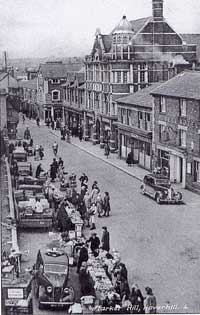
Market Hill 1948
|
|
1948
|
In 1948 the High Street and market looked like it would have done since the First World War. Stall holders now had motor cars or vans to come to market, but the layout of buildings and streets remained the same. Within a dozen years there were plans to change all that, and work had begun.
In 1948, a start was made on the Parkway Estate, and the first twelve houses were built in Park Avenue. Later when the road layout was changed, the road was re-named Ash Grove and the houses re-numbered. The first twelve homes were started by the Co-operative Building Society and taken over by Haverhill UDC. The Haverhill War Charities Club did not finally close down until 1948. Elsewhere the London County Council was trying to relieve overcrowded and bomb-damaged London by building new towns like Crawley and Harlow, but these were much nearer to London than Haverhill.
|
|
1949
|
Faced with continued male unemployment, the then Haverhill Council determined that they must do their utmost to build up the town to become a self-contained community with adequate financial resources and offering full and varied opportunities for employment. Unhappily the Council did not possess the necessary resources to build the houses and to provide the services which would be needed by the new population. The main problem was the cost of the new sewage works that would be needed.
FRom 1945 to 1949 the Haverhill UDC built 68 new dwellings.
|
|
1951
|
The Festival of Britain took place in 1951. One project was to be the tidying up of bomb-sites and other eye- sores. In Haverhill it was planned to tidy the disused churchyard in the middle of town. Over the following year it was also levelled to improve the view of the church.
|
|
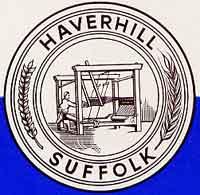
The Town Badge |
|
blank |
A further town project was to find a badge to express the identity of a new Haverhill, looking to the future, but remembering the past. The town guide had a cover design by Philip Dickinson which reflected the town's past and this design was adopted. It shows a handloom of the 17th century type on which the town's modern prosperity was based, together with an ear of oats, reflecting the old English name of the town, and an ear of wheat. In 1951 agriculture was still an important part of local life, much more so than in 2002. In September 1951, something happened which was to have a far-reaching effect on the future of Haverhill. The Government announced its intention of introducing a Bill to provide financial help to local authorities prepared to undertake
major expansions to relieve overcrowding in congested areas. The Haverhill Council immediately announced that they were prepared to participate in the expansion of Haverhill to a population of between 8,000 and 10,000.
|
|
1952
|
In August 1952, the Town Development Act was passed to facilitate the removal of London "overspill population" from a war torn capital into greener pastures outside London. It gave the London County Council powers to give financial assistance to receiving authorities, and laid out government assistance as well.
However, as we have seen, long before this date, representatives of the Haverhill Council and of the London County Council had met at the former's suggestion to discuss the possibility of Haverhill taking population and industry from London. It is for this reason that Haverhill claimed to be a 'pioneer in town expansion'.
|
|
1953
|
Between 1951 and 1955 a lot of ground work and negotiation had to be done, and in the meantime the Urban District Council were continuing on their own to expand Haverhill the best way they could. By the beginning of 1953 the Parkway Estate was becoming one of their biggest housing developments and they planned for sixty seven new houses to be built that year.
Children's playground equipment was set up on the Recreation Ground, a gift from a Mr Bennett Whiting to mark the coronation.
The Co-op dairy was modernised and enlarged to meet the growing demands of Haverhill.
The Chamber of Trade presented the Haverhill UDC with a Badge of Office for the Chairman of the Council.
In May, 1953, a remarkable event occurred when the Augustinian order of Friars moved back to Clare Priory, having been absent since 1538. The Priory was a gift to them from the daughters of Lady May, who had wished to see the Friars return to Clare.
|
|
1954
|
Several towns in East Anglia had expressed a wish to expand and in January 1954 came the earliest official announcement from the London County Council of the towns they were considering for the reception of an overspill population. The towns named were Haverhill, Sudbury, Bury St Edmunds and Thetford. These towns, the LCC stated, have signified their agreement, in principle, to a policy of expansion and now experts are scrutinising the extent of population that each can take.
Pye Telecommunications Ltd came to an old building in Lordscroft Lane, Haverhill in 1954, although by 1957 they would build a new factory in Colne Valley Road.
|
|
1955
|
The London County Council was promoting the idea of moving to expanding towns at the British Industries Fair in May 1955. Industries were shown the advantages of moving out of London. Amongst others, Haverhill was mentioned, saying there were modern conditions for living and working and provision was to be made for the extra labour force required by firms which were moving. In a brochure produced by the LCC Haverhill was described as:-
"A small town at the head of the Stour valley, with over 300 years of industrial tradition, London is 45 miles away. Present industry includes clothing, light engineering, brushes, rope and horsehair products. The Haverhill Council is providing two industrial sites of which parts may be leased or purchased, situated in the Duddery Hill and Hamlet Croft areas and in the meadows on the far side of the cricket ground. Ground rents for these sites would vary between £75 and £100 per acre per annum and the purchase price would be subject to negotiation, The Council is also prepared to consider erecting factory premises on this land and leasing for not less than 21 years at an all in figure of approximately 2/- (10p) to 2/6 (12½p) per square foot per annum."
In September 1955 the LCC gave its approval to the
transfer of 5,000 Londoners to Haverhill. In December of that year, the London County Council, the West Suffolk County Council and the Haverhill Urban District Council combined to stage an exhibition in the town hall with the aim of bringing industry and people to the town. It was called 'HAVERHILL OF THE FUTURE'.
The exhibition was opened by Mr J Catlow, assistant secretary to the Minister of Housing at Whitehall. In his speech he said the Minister had decided to grant 50% of the cost towards the reorganisation of water and sewage works and also help by paying an annual contribution for ten years on every house built for the occupation of Londoners.
Outside Haverhill, at Little Wratting, Mr Frank Sainsbury, the owner of Blunts Hall Farm, died. This farm had been owned by a Sainsbury for over 50 years. The estate was largely sold off, but the firm of J Sainsbury retained 68 acres, situated on the Haverhill to Bury road. This action was to provide Haverhill with one of its major employers. Haverhill Meat Products began curing bacon on the site in 1958.
|
|
1956
|
In March 1956 West Suffolk County Council Planning Department published an outline plan or town map for Haverhill which proposed increasing the population of 4,222 to 9,750 over 20 years. Some 5,000 people would come from London. The report noted that the market was held on Fridays on Market Hill in the High Street by Chapmans, Lloyds Bank and St Marys' Church. This plan was subject to government approval. The market square which we know in 2000 was not a square at this time, being occupied by narrow rows of houses.
The corn exchange, cattle and general market occupied half an acre on Withersfield Road, which was felt to be adequate.
During 1956 building of the first new factories started and Polak and Schwarz said that they hoped to start production in September in their new premises off Duddery Hill. This was the beginning of what is today the vast complex of IFF.
Some ex-members of the Haverhill Air Training Corps may remember being visited and inspected by Douglas Bader in Mount Road in 1956.
|
|
1957
|
Two new firms had official openings in 1957. In February Hille Metals Limited of Watford, opened a new factory at Hamlet Green and in June, Polak and Schwarz opened at the top of Duddery Hill, both openings followed by a reception at the Rose and Crown. These were the first factories to arrive under the town expansion scheme. Polak and Schwartz went on to expand and be taken over by today's IFF, or International Flavours and Fragrances, a massive investor in Haverhill still in 2002. The Polak and Schwartz factory won the West Suffolk Architectural Award for the best industrial building erected in the county from 1954 to 1957.
Pye Telecommunications opened their new factory in Colne Valley Road, although they had been in Haverhill since 1954.
In May 1957, at a Council Meeting it was stated that the plans and layout for the first part of the London County Council development at Burton End was now ready. One hundred and eight dwellings were to be erected for men with families moving with a new factory from London. This would be the first stage of the LCC part of the Parkway Estate. In the early days this was also known as the London Estate.
On 18th December, 1957, the Minister of Local Government and Housing officially approved Amendment Number 1 to the West Suffolk Development Plan originally approved by the Minister in July 1954. This amendment added the new Haverhill Town Plan to the County Plan. It was now official government policy as well as County and Town policy, to expand Haverhill to 9,750, from its estimated population in 1955 of 4,222.
|
|
1958
|
During 1958 expansion plans really got moving. The official exchange of documents took place between the UDC and the London County Council for the transfer of industry and population from London. Town expansion was now signed and sealed as official policy. In March of that year the Highways Committee allocated £40,000 for the construction of the Relief Road which became known as the Pightle Extension.
On June 13th 1958 the Minister of Housing visited Haverhill to lay the foundation stone for a new factory to be built at Hamlet Green. It was the first one actually built by the London County Council for the Urban District Council and was to be leased to a firm called Mount Furniture Co. By this time the construction of the Hollands Road industrial estate infrastructure was almost complete and the Minister performed the official opening
of that as well. At first this was called the Bumpstead Road Industrial Estate.
|
|
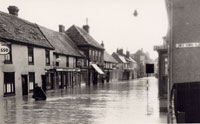
Queen Street |
|
blank |
1958 is the year a lot of people remember as the year of the flood. After a terrible storm in June most of the High Street and Queen Street area of the town, including the Pightle, was flooded. From Friday 20th June to Friday 27th June, some 3.89 inches of rain fell. Thursday 26th June was quite a dry day, but overnight there was a downpour, and about 1.7 inches of the week's total fell in that night. People woke up on Friday the 27th to find their homes flooded. These were the worst floods in Haverhill for fifty-five years since those in 1903. From the Co-Op to the Plough Inn in Withersfield Road, the water was up to four feet deep. No main road out of town remained open and most villages around were also flooded.
|
|
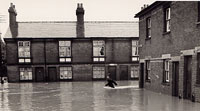
PC Saunders on patrol |
|
|
The South-West Suffolk Echo reported that from their records the flooding in 1958 was probably worse than in 1903. In 1903 the water reached Attertons gates, but this time it penetrated the works of that firm now called Atterton and Ellis. A photograph of PC Saunders on patrol wading through the floods at the Crowland Road and Withersfield Road junction was published in the Haverhill Echo. It made the front pages of some national newspapers.
|
|
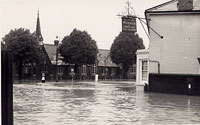
Cangle Junction flooded |
|
blank |
Passengers getting off the morning train at Haverhill were stranded because Station Road and Wratting Road were impassable.
By late Friday afternoon the floods had moved away, and traffic could pass through Haverhill once again. But the water had only moved down the Stour valley to flood Clare, and Sturmer village.
In the aftermath people were warned to boil their drinking water. The Haverhill Fire Brigade were supported by firemen from Gurteens, and the Westgate Brewery in Bury also sent one of its fire engines to help pump out flooded cellars Friday and all through Saturday. RAF Stradishall sent special heaters to dry out premises. Newman and Co advertised 10% off paints and decorating materials for a period of one month to assist victims of the flooding.
The inadequacy of the old water system was discussed and in September a £98,000 scheme was announced by the Ministry for the reconstruction of the sewage works to cope with the extra 7,500 people.
Also in June British Railways introduced Diesel Railbuses on the Saffron Walden branch line, serving Haverhill, Bartlow and Audley End. The journey from Audley End to Haverhill was reduced from 37 minutes to 31, and the new trains were hoped to help balance the books by cutting costs. The railways now had to pay year by year, and even the Cambridge region had to balance its accounts. The Chairman of Haverhill UDC, Mr R C Poole, welcomed the better trains but pointed out that the service was now reduced to two down trains for Haverhill, and called for consideration of better means of travel to London.
In July 1958, a start was made 'on the ground' to put into effect an agreement with the London County Council to expand Haverhill under the Town Development Act to 10,000 people. The "London estate", extension to Parkway, was begun.
The Co-op opened its new Furnishing show rooms, with a Ballroom, Dining Room and Lounge above it. The dance hall was called the Bigmore Hall, and was in Swan Lane.
In November the Council announced that arrangements were nearly complete for the HUDC, in conjunction with the LCC, to lease a factory on the new Hollands Road estate to Mansol (Great Britain) Limited. Work would now begin on developing the new factory buildings to the requirements of each firm.
Things were really starting to move in Haverhill by the end of 1958.
At Little Wratting, the Haverhill Meat Products firm started to cure bacon for the firm of J Sainsbury, who were its owners.
|
|
1959
|
In January gale force winds resulted in two chimney stacks falling at Parkway estate. Snowfall followed by a thaw produced yet more flooding. But thankfully it was not as widespread as in 1958.
The Hollands Road industrial estate was being laid out and factories started on. Mansol's factory would be the earliest to be completed. They would start production on 1960.
|
|
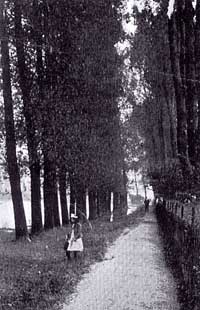
The Meadows before Relief Road |
|
blank |
In February 1959 a ceremony was held when the first sod of earth was lifted to mark the clearing of the site for the Pightle extension, the first section of the Relief Road. There was actually BBC coverage of the ceremony when Mr R C Poole, the Chairman of the Urban District Council, was interviewed for the regional news. The Relief Road was built over the meadows footpath from Hamlet Green to Lordscroft Lane, and there were a lot of people who were sad to see their disappearance.
In London, the LCC were still promoting the idea of moving to expanding towns. In May 1959 the customary hoardings went up around Eros to prevent vandalism on Cup Final Day and on the hoardings were posters which read:
"There is space for growing industry in expanding towns, Bletchley, Swindon, Aylesbury, Haverhill, Bury St Edmunds and Thetford. Ample labour is assured. Financial assistance possible, Modern homes for work people."
In August Hamlet Croft Football Ground was to be levelled off, removing the notorious playing slope with its 12 feet fall at a cost of £3,522. Meanwhile the Haverhill Rovers would play next season on the Recreation Ground.
Anglia Television came to Haverhill Recreation Ground with a roadshow to publicise its opening. A helicopter was a star attraction.
Haverhill's two electoral wards called Haverhill North and Haverhill South were to be increased to four, called Castle, Cangle, Helions and St Mary's.
By September, Mount Furniture had moved several families into Haverhill and the 50th overspill house was allocated to one of their employees. They had moved from a flat in Stepney.
By the autumn of 1959 the new Secondary Modern School was finished on the upper side of the Parkway Estate. Pupils and equipment were transferred from the Cangle after the half term holiday in October and the new school was officially opened in June 1960. It is now called Castle Manor School.
Union Square between Queen Street and the Pightle was now starting to be demolished for redevelopment. The old workhouse had stood here.
|
|
1960
|
At the beginning of 1960 another part of old Haverhill went into decline. In January of that year it was stated that the use of the cattle market was declining. For the first time ever there was no fat stock sale at Christmas. The market was officially closed in February. The days when the market was booming were recalled in an old register of stock from 1899 which recorded that 130 head of oxen, 90 sheep, 300 pigs, 300 poultry and 72 horses passed through every week. The cattle market was held behind the Rose and Crown and it was in August 1961 the decision was taken to use it as a car park.
Work started on the new automatic telephone exchange in January 1960. It was finished by October that year.
The town centre was by-passed by the completion of the Inner Relief Road, which we now call Ehringshausen Way. The Pightle extension was officially opened by Lord Chesham, Joint Parliamentary Secretary to the Minister of Transport, in April 1960, just in time for Easter. The Pightle and Lordscroft Lane thus became turned into a major road.
Haverhill Cricket Ground was badly affected by the alignment of the new road. Most of all a wonderful line of chestnut trees on the southern boundary had to be felled. Two or three still remain next to the Relief Road.
Other services in the town were to be extended as well and Haverhill's first town bus service was set up by Premier Travel.
This service was unique because at that time Haverhill was the smallest town to have its own internal bus service. In January 1960 service 54 was officially inaugurated, after a year of preparations.
|
|
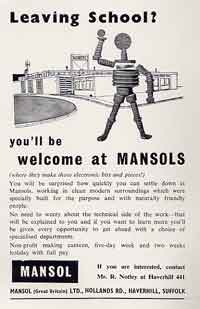
Mansol Advert 1964 |
|
blank |
Mansols were the first factory to be completed at Hollands Road Industrial Estate, and they moved here from Croydon, and started production in 1960. They made sintered glass products for the Electronics industry, to hold transistors and diodes. It was a product that needed a bit of explanation to new recruits!
Mansols were one of several enterprises which actually moved into their new factories in 1960, but unfortunately Mount Furniture only survived in the town for a short time. By October 1960 they announced closure which meant the loss of 60 jobs. Twenty had already been made redundant and the remaining forty would stay until the closure. This came as a great blow because the factory occupied a prestige site. However, Mr I Bloohn, manufacturer of office furniture, expressed interest in the site and by November his company had taken occupation. Later they were taken over by Project Office Furniture who still manufacture there today.
Other arrivals in 1960 were Finemetals Ltd, wholesale jewellers, and Halliburton, making equipment for oilfields.
The building of the new Police Station in Camps Road was started during 1960 and in November, plans for Place Court and the Clinic were announced. The Secondary Modern School was opened in Eastern Avenue on the Parkway Estate. Today it is called the Castle Manor School. It replaced part of the work of the Cangle School, but the primary and junior schools remained at the Cangle School on Withersfield Road for several more years.
At Little Wratting the firm of Haverhill Meat Products opened a new bacon factory.
|
|
1961
|
The town centre improvements were begun in 1961. On the site previously occupied by Jarvis the butcher's shop in Queen Street, the old underground brick culvert, running from
Camps Road was being replaced by a 48 inch sewer pipe. This was being done to stand up to the extra traffic when Camps Road was widened. Mr Dickinson wrote in the Haverhill Almanack and Directory for 1961 as follows:-
"Perhaps the greatest change, and the most debateable, is the destruction of Jarvis' butchers shop on the corner of Camps Road. At long last this narrow and dangerous corner has gone forever, together with the ugly and derelict houses behind as far as Peas Hill. The whole centre of the town will be opened up and the fine church more easily appreciated." Today's Market Square was therefore half-way to its final form, but some buildings still remained on the Church side.
The Directory also noted that the population was 5,200, Market Day was Friday and early closing was on a Wednesday.
In February that year the Haverhill Urban District Council asked the West Suffolk County Council and the London County Council to extend the overspill plan by 5,000 and approved in principle the use of 42 acres of land in the Clements Lane area for housing. The extra 5,000 people would bring the numbers to the 10,000 proposed by Haverhill originally.
1961 produced the handing over of keys to the one thousandth tenants of the London overspill scheme, and more firms moved to Haverhill during 1961, like Neon Signs and Lighting from Ealing.
|
|
1962
|
In 1962 the West Suffolk County Planners published The First Review of the Haverhill Town Map. Its view was that the population would be planned to rise from 5,446 to 18,500. It included 9,000 people who would move in from London by 1981. Design work on the Clements estate was started by the Great London Council.
The Colne Valley Railway Line was finally closed down for goods traffic, leaving the Stour Valley line to continue until 1967. Haverhill South had not seen passenger traffic since 1924.
The new magistrates court room was used for the first time. The police station and courthouse were designed by the West Suffolk County Architect Mr John Crease and built by Messrs Kerridge of Cambridge. The opening ceremony was performed by the Lord Chancellor, Viscount Kilmuir. This court was to close in 1998.
|
|
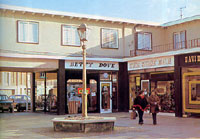
Queens Square by 1975 |
|
|
Queens Square was completed in January 1962 and sold to the Prudential Assurance Co for £70,000. Many of the shops on the north side of Queen Street were demolished for redevelopment, but the south side remains mostly intact today. A big event in March that year was the opening of the Fine Fare Supermarket.
By the end of 1962 the old Empire Cinema had closed down. In October the building was re-opened as a cycle and motor cycle store and was called the Empire Cycle Stores.
Pasks and Sintacel came to Hollands Road in 1962.
|
|
1963
|
During 1963 a lot of building work was undertaken. In January work started on Place Court old peoples' home, the clinic and the ambulance station. In March the roads and services were being constructed for the Clements Estate and the tender was awarded for the first 142 houses. Sainsburys were building an extension to Blunts Hall and the old peoples' bungalows were completed in Withersfield Road by April that year. In May, work was started on the Secondary School extension. The air raid wardens' post was still on the recreation ground and the Haverhill Council knocked it down.
Also in May 1963, at a final cost of £123,000, the new sewage works was opened by Louis Goodman, Assistant Secretary at the Ministry of Housing and Local Government. It was built with expansion in mind and could be extended to cope with a population of 17,500.
By September 1963, Place Court had taken its first resident.
At Little Wratting Blunts Hall was demolished to make way for the expansion of the thriving Haverhill Meat Products factory complex.
|
|
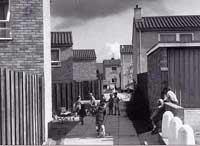 Award winning Clements
Award winning Clements
|
|
1964
|
The letting of the Clements Estate was started and it was decided to make it a dogless area. It would seem however that that decision did not stand for long! At the end of the year, work was started on the shops with flats above, in front of Harewood Terrace. It was in February 1964 that the Urban District Council gave its approval for the 'Mount' to be demolished and a row of houses were later erected on the site.
Early in 1964 the Council took a special census which showed that Haverhill's population was then 7,239. By March 1964, 575 houses had been erected and there were a further 238 under construction. Some 26 new factories had also been built under the town expansion scheme.
In April 1964 work was started on the alteration and enlargement of the Post Office.
Place Court, the clinic and the ambulance station were officially opened in March by Lord Newton, the Parliamentary Secretary to the Ministry of Health. The building of Place Farm School was started in 1964.
The gymnasium was completed in the Secondary School in May 1964 and also the playing field was used for the first time. The extension was completed in September.
Burton Cottage came into use as a Youth Centre on a limited basis in June.
|
|
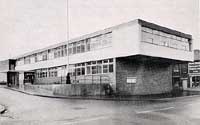
New Council Offices 1964 |
|
blank |
In July the new Council Offices in Lower Down Slade were officially opened by Mrs Evelyn Dennington, chairman of the expanding towns committee of the London County Council. They were built on the site of the old Temperance Hotel.
Another estate was started in 1964 which was in the Cambridge Way area. The style of these houses was somewhat revolutionary as they were constructed in a factory and then erected on site. Beaumont Vale and the Castle Estate were also started. Several firms expanded
that year too, including DCMC, Mansols, IFF (the former Polak and Schwarz) and Koch Laboratories.
|
|
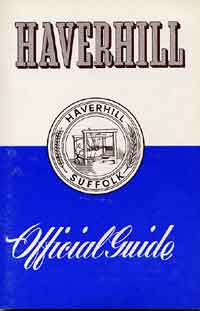
Official Guide Book 1964 |
|
blank |
An official guide to the town of Haverhill was published by the Haverhill UDC in 1964. It was written by Philip Dickinson, and contained a wealth of detail about the town at the time. It reflected the views of the 1960's, when slum clearance was thought to be a good thing by and large, and conservation of old buildings was only a minority interest. By 2002 we appreciate many of Haverhill's fine Victorian buildings, but in the Guide, it lamented "Unfortunately much building was done in the middle of the 19th century, a very bad period from an architectural point of view."
The guide recorded that the Market Hill was undergoing further improvements to make it a worthy town centre of a greater and newer Haverhill.
The market was still held on Fridays in the Market Hill, which by this time was confined to the wider part of the High Street, just on the south-eastern side of St Mary's Church. The open square called Peas Market Hill by the year 2000, was still being cleared of old established dwellings and shops during the early 1960's. Mr Dickinson noted that the market tolls were paid to the Urban District Council as successors to the Lord of the Manor, and formed part of the income of the town.
Gurteen's factory was established some time as early as 1784, and was still the one of the largest employers in Haverhill. In 1964 Gurteens were making 400,000 garments a year in Haverhill.
Two firms established in the 19th century were still operating. These were Atterton and Ellis, and the Haverhill Rope, Twine and Sack Company. The Rope Walk in Camps Road was 320 feet long.
Mr Dickinson noted that three new industries arrived between 1940 and 1955. These were Vitovis, Addis, and Pye Telecommunications. Vitovis had taken over the premises of the Haverhill Steam Flour Mills in the Pightle, and by 1964 made animal feedstuffs. In 1964 Addis were making Wisdom toothbrushes in Haverhill, and were another one of the town's largest employers.
|
|
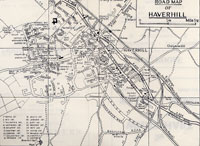
Haverhill in 1964 |
|
|
But only since the agreement with the LCC of 1955 has Haverhill really become industrialised, with 25 new undertakings arriving between 1957 and 1964, including Refrigeration Appliances, A E Kevern, and Koch Light Laboratories.
The Haverhill Co-op was the largest retailer in Haverhill in 1964, with its self service grocery department, its furnishing department, supplemented by the Ballroom Dining Rooms and Lounge.
The guide noted that the population for June 1964 was estimated at 7,240. Market day was on a Friday and Wednesday was Early Closing Day. The water supply came from the West Suffolk Water Boardpumps in Camps Road, but the Council provided the Sewage Works in Coupals Road. A Roman Catholic Church was in the process of construction in Queensway on the Parkway Estate, to replace the wooden building in Withersfield Road. Boys and girls who needed a Grammar School had to travel to Sudbury, some 18 miles by school bus. The library at this time was in the Town Hall.
|
|
1965
|
On 1st April the London County Council ceased to exist and was replaced by the Greater London Council under the terms of the London Government Act of 1963. All the LCC town development agreements were taken over by the GLC.
By June 1965 two classrooms were completed in one wing of Place Farm School, and by August the new public counter was opened in the Post Office. To give an indication of how quickly Haverhill was expanding, by October 1st 1965 the number of firms who had moved in was thirty seven.
|
|
1966
|
The Chalkstone Housing Estate was started by the GLC. All of the town development houses in Haverhill before 1974 were designed, financed and built directly by the London County Council and then by the Greater London Council after 1965. The population in 1966 was estimated at 9,000, a growth of 2,000 in two years.
|
|
1967
|
The Stour Valley line of the Great Eastern Railway now part of British Railways, was closed down. The last train had left Haverhill forever.
In 1967 the Council obtained temporary planning permission for a change of use from shop site to a market for one day a week (Friday) and a car park for the rest of the week. This site is known today as Peas Market Hill and is just by St Mary's Church. At some point the market moved out of the High Street on to this new area.
|
|
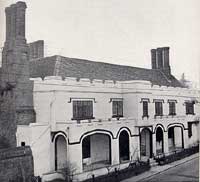
The Old Vicarage |
|
|
It seems that the house now called Anne of Cleves house, gained this name in 1967, when it was put up for sale. Anne of Cleves was granted the parsonage in Haverhill in 1540, but this building burnt down in 1667, along with most of Haverhill. Afterwards, the local vicar, or parson, was allowed to move to a surviving farmhouse, which naturally became called the vicarage. This property belonged to the Lord of the Manor, and in later times was the Manor House of Haverhill and home to the Beaumont family, who were the Lords of the Manor. The local estate agent overlooked the Manor House link, but connected this building to Anne of Cleves, and marketed the property accordingly.
|
|
1968
|
Ten years after the great Haverhill floods of 1958, despite new drainage levies, floods occurred again in mid September 1968. Some 2.7 inches of rain fell in 24 hours, and much of Southern Britain was also under water. The Haverhill Echo of Thursday 19th September said "they were if anything, greater in intensity than those of ten years ago". It rained all the weekend and on Monday 16th September the town was flooded "to the knee" as the Stour Brook overflowed. Withersfield Road, Queen Street, The Pightle and Hamlet Road were all flooded. "The Relief Road (Ehringshausen Way) resembled a canal". The Council Offices in Lower Down Slade were flooded and records in the cellar were destroyed.
By mid morning the water had subsided but there was a thick layer of slushy mud left behind clinging to floors and walls.
|
|
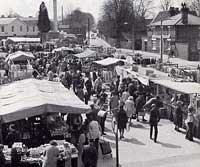
The new Market Hill
|
|
1969
|
Planning permission was granted for St Mary's Square (Peas Market Hill) to become a paved and planted open pedestrian area, but with a market on one day a week, on Fridays. This made the temporary permission granted in 1967 into a permanant permission for the market, and changed the Square from a car park to a pedestrian amenity.
|
|
1970
|
In 1970 Gurteens opened a branch factory in Southern Ireland. Branch factories had already been opened in Ely and Hadleigh. Work began on modernising the Haverhill factory inside the Victorian shell of the building. Trade moved over to lightweight men's clothing. In the 1960's the heavy type of working garment disappeared, and by 1970 Gurteens stopped making overalls. However, the making of coir mats was still carried on, together with an expansion in fabric for deck chairs and awnings.
|
|
1971
|
When the West Suffolk County Council approved the ultimate expansion of Haverhill from 18,500 to 30,000 they - with the full approval of the Haverhill Council - commissioned the eminent architect and planner, Sir
Frederick Gibberd, to prepare a master plan, and this was published in 1971.
|
|
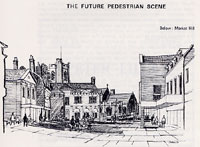
Vision of Pedestrianisation |
|
|
The Gibberd plan was the subject of a public exhibition at the Town Hall to explain the proposals to the towns people. It included the pedestrianisation of the High Street and Queen Street, both of which continue to be problematic into the year 2000 because of the need to service the shops and premises. It also criticised the high density layouts of the GLC estates. Haverhill featured on the Desmond Wilcox programme, Man Alive and the subsequent Talkback programme. The subject was People -v- Planners and was about the Clements Estate. One famous quote from a resident "These things are all right in practice but they don't work in theory"! Everyone knew what was meant, and from 1988 and throughout the 1990's the St Edmundsbury Council would have to spend over £8 million on environmental and home improvements at Clements. On October 1st 1971 the Haverhill Sports Centre was opened, built by West Suffolk County Council.
Gibberd's plan was to respect the 300 foot contour as the reasonable limit to the town's growth. There would be an overall landscape design, with a pattern of open spaces. The old railway line would be a walkway to give a sequence of views up the valley sides. Estate densities would be reduced from between 38 and 54 people per acre, to between 31 and 40 persons per acre. A new feature of his designs for the Chalkstone Estate was the inclusion of homes with integral garages.
|
|
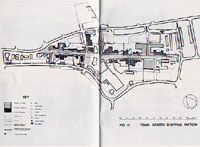
Plans for a Southern Spine Road |
|
|
In the town centre the market would be retained on its new "piazza" site, while Queen Street and High Street would be pedestrianised. Traffic would bypass these streets on new spine roads. The southern road was still not built in 2002, and these "precincts" would still not yet be more than partly pedestrianised. Without a satisfactory way to service the businesses in the High Street pedestrianisation will remain a dream for the rest of the century.
The 1971 census showed Haverhill's population as 12,430, still well below its planned targets.
|
|
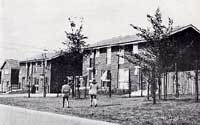
The new Chalkstone Estate
|
|
1972
|
By 1972 development was moving ahead on the Chalkstone estate. In early 1972 the Chalkstone Middle School opened and Castle Hill School opened in September 1972.
Between 400 and 500 of the new homes were still empty at the start of 1972, so new contracts were put "on hold". Early work was undertaken on the West Town Park, and further work undertaken on the 9 hole golf course ready for 1973 opening. Motts and Chalkstone playing fields were completed. The new Local Government Bill included plans to move Haverhill, the Thurlows, Bradleys, Wrattings, Kedington, Barnardiston and Withersfield into Cambridgeshire. The Local Government Act which finally emerged in 1972 left them alone in Suffolk.
Planning permission was sought to turn the old RAF Stradishall base into a prison for 500 men and detention centre for 200 youths. Plans for a 2,000 acre reservoir at Great Bradley were being considered.
West Suffolk County Council revealed plans to close the Cangle School. It was until recently, the largest primary school in the country with 1,000 pupils and there was a project by the County Council to replace all its Victorian schools. It would be replaced by three lower schools, and the site used for housing. The Cangle School would not finally close until 1988, despite these early plans.
|
|
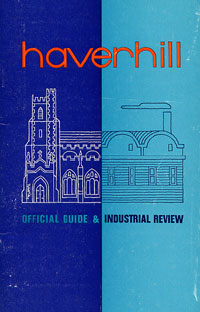
The 1972-3 Guidebook |
|
|
A new guidebook was issued at the end of 1972 or early 1973. It was called "Haverhill - Official Guide and Industrial Review". By now the market was well established on the cleared area called Peas Market Hill, and Market Day was Friday. Wednesday was still officially Early Closing Day. The guide was partly meant to acknowledge the new Gibberd Masterplan. "When you come to Haverhill you are in a town which is now being planned in its entirety. Haphazard growth is now a thing of the past. The simple purpose of the Masterplan...is to provide a guide for development. Without it there would be chaos," it proclaimed.
At Little Wratting the Haverhill Meat Products Factory opened up new offices and plant. By now this factory was employing 1,600 people on site.
|
|
1973
|
Castle and Puddlebrook Play Areas were completed. The golf course was also finished.
However, the Playhouse Cinema closed in the High Street. Cinemas were out of fashion at this time as television had largely replaced its attractions.
|
|
1974
|
Haverhill UDC let its last housing contract to build 306 dwellings on the Chalkstone Estate. All the streets were named after birds. The Council also let a contract for a
new swimming pool. All of these projects would be taken over and completed by St Edmundsbury Borough Council in the next three years.
Under the Local Government Act 1972 all existing local authorities, including Haverhill UDC, were swept away on April 1st. West Suffolk County Council was abolished and joined with East Suffolk to produce Suffolk County Council. The urban district of Haverhill was joined with Clare RDC, Thingoe RDC and Bury St Edmunds Borough Council to form the St Edmundsbury Borough Council. Haverhill's strong local identity was felt to be under threat from the weight of Bury St Edmunds. But at least Bury was also an expanding town in the GLC's Town Development scheme, so there was much common ground in their knowledge and experience of new housing and industrial development. Under the Water Act, 1973 the council-owned sewage works at Coupals Road was transferred to Anglian Water.
|
|
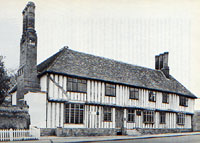
Ann of Cleves House |
|
|
In 1974 the house which had now become known as Cleves House, or Ann of Cleves House, was remodelled. The 19th century veranda style frontage was removed, and the appearance became that of a half timbered 16th or 17th century manor house. This was a much more fashionable front than the previous one, and suited much more the idea of a house dating back supposedly to the age of Henry VIII.
|
|
1975
|
Work began on extending Chalkstone Way to the Sturmer Road, including crossing the Stour Brook.
|
|
1976
|
The Golf Course had its official opening as a municipal course. The bridge over Stour Brook was completed so that the Chalkstone Way link to Sturmer Road could be opened. In 1976 William C Blake, the former Town Clerk of the old Urban District Council, wrote "It had been hoped when the master plan was prepared that Haverhill would grow to 30,000. The economic recession of the country in recent years has slowed down the rate of growth, and it is now evident that the town will not achieve its planned optimum population until some years after that originally planned.
The most recent estimated population (mid 1974) is given at 15,000; 2,200 of the 4,500 houses in the scheme have been built while over a million square feet of industrial space has been put up, in addition to the very large premises of Her Majesty's Prison just outside the former Urban District boundary. As a result of the expansion, many new amenities have been provided, including new schools, library, clinics, fire station, sports centre with indoor swimming pool, golf course, playing fields, youth centres, etc. Haverhill is indeed a vastly different place now from the dying town of the late 1940s."
|
|
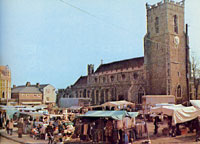
The new Saturday Market |
|
|
By 1976 the Market was moved out of the High street and on to the newly created Peas Market Hill. It was now operating on Saturdays as well as the traditional Friday. People quickly came to call it the Market Square. Within 25 years there would be calls to move it back to the old Market Hill which was in the High Street.
|
|
1977
|
Sainsbury's store was opened at Jubilee Walk together with the bus station and Brook Service Road car park. The Sainsbury's store is now occupied by Leo's.
The footbridge over Wratting Road was installed. The first attempt was aborted when the Erecting Gang failed to turn up - after all the road closures had been imposed!
The Haverhill and District Local History Group started to
publish its journal "Haverhill Historian".
A Council contract for 264 dwellings at Chimswell Estate was substantially completed having taken about 3 years, as was a contract for 306 dwellings at Chalkstone. It was a big year for birds and flowers, as the streets on Chimswell were named after flowers, and those at Chalkstone after birds.
|
|
1978
|
The Samuel Ward Upper School was opened off Chalkstone Way. The Ward family had been notable Puritan preachers in Haverhill in the early 17th century. In 1605 Samuel Ward was so prominent that he was appointed as Town Lecturer, or Preacher, at Ipswich, a post he held until his death in 1640. He was uncompromising in his personal views of how the Reformation should be carried forward.
Westbourne Court sheltered accommodation was completed on Wratting Road, but only sporadic new council house building would take place after this date in Haverhill until a final contract was let in 1990. The Council sold 5 acres of land at Chalkstone Estate to the Jephson Housing Association to build 96 homes.
|
|
1979
|
The new police station was built.
|
|
1980
|
The Victorian gas holders in Withersfield Road were knocked down.
|
|
1981
|
Nearly the whole of December saw thick snow over Suffolk. The road from Haverhill to Bury was sometimes impassable.
|
|
1982
|
January had another two weeks of snow, but it was not as bad as in the previous December.
In 1982, the international biotechnology firm Genzyme opened a site in Haverhill for manufacturing pharmaceuticals.
|
|
1983
|
On 1st April 1983 the Town Development Agreement with the GLC officially ended. In practice, development had halted years before, but the various subsidies and allowances now ended. St Edmundsbury Borough Council purchased the remaining undeveloped GLC landholdings at outstanding debt levels.
|
|
1986
|
Ten one-bedroomed bungalows in Moat Walk and Bodiam Walk were completed by the Council. Such specialised homes, more suitable for older people, built in relatively small numbers, were characteristic of Council house building in the 1980's.
|
|
1987
|
Another ten one-bedroom bungalows were built by St Edmundsbury Council on the Castle Estate.
|
|
1988
|
The Cangle School closed, although its replacement had been planned since 1972.
The Buryhill Land Company was set up as a joint venture between St Edmundsbury Borough Council and Morgan Grenfell and Company Limited, a merchant bank. The aim was to sell all of the Council's 165 acres of undeveloped land holdings to the company who would proceed to develop roads and services on the land and then sell land to developers in appropriate parcels. This sale included 41 acres off Chalkstone Way and 24.5 acres off Parkway Estate in Haverhill. After an initial payment the council would receive over £5 million a year until 1992. St Edmundsbury Borough Council agreed to start Phase 1 of the refurbishment of the Clements Estate, including
considerable environmental enhancements. Other phases would follow this and continue throughout the 1990's.
The Haverhill Meat Products factory at Little Wratting began to produce cooked meats for Sainsbury's Supermarkets in a new part of the factory.
|
|
1989
|
Haverhill Town Council was formed following extensive local consultations and a public enquiry, to better represent the views of the people of Haverhill and promote the town and activities in it.
Cleales Garage and the Playhouse cinema in the High Street were demolished to make way for new development.
By the end of 1989 the demand for housing land began to falter, following a fall in house prices.
|
|
1990
|
In 1990 the last of the new houses built by St Edmundsbury Borough Council were planned. A contract for 41 dwellings at Chalkstone Way was arranged by way of a Deferred Purchase agreement with a Merchant Bank, Messrs Morgan Grenfell. Government restrictions on new building and the new housing subsidy arrangements had ended the era of new Council house building. All new social housing after this time would be provided by Housing Associations. September was notable for the announcement in the Haverhill Echo of a 'Blitz to get Queen Street pedestrianisation to work better.' Also in September the out of town Sainsburys store was opened, and their Jubilee Walk premises were vacated.
|
|
1991
|
The Co-Op closed its shop in the High Street and reopened as a supermarket (Leo's) in the newly vacated Sainsbury building in Jubilee Walk. Princess Anne opened the Citizens Advice Bureau's new premises.
|
|
1992
|
The High Street received 'wall to wall paving'. £70,000 was spent on the restoration of the Old Independent Church's organ. The first residents moved into Hanchett Village.
In April, the East Town Park was opened to the public, and in August, the Haverhill Sports Centre was fitted with two new giant water slides.
The Buryhill Land Company ceased trading. This company had been set up by St Edmundsbury Borough Council in 1988 to buy all the Council's undeveloped land. The continued depressed prices for housing land following a slump in house prices made the company's future untenable. In June, St Edmundsbury Council repaid all of its loan debt to obtain debt free status which allowed it to buy back the remaining land holdings of the company. In Haverhill, the Council re-acquired 28.6 acres at Chalkstone and 22.15 acres at Parkway.
|
|
1993
|
After years of campaigning, the town's new southern bypass was started in August. The work revealed 1st century Roman brooches and some iron age finds. There was flooding in October and, more significantly, a complete renovation programme was started on the Town Hall.
In September the Sports Centre was refurbished, with a health suite, fitness studio and a soft play area.
The Little Wratting factory of what had always been called Haverhill Meat Products, opened a new abattoir on the south side of the Bury Road. The firm became called Newmarket Foods for a time and later became part of Grampian Foods, but its main customer remained the supermarket chain of J Sainsbury's.
|
|
1994
|
The Buryhill Land Company was officially put into liquidation by its owners although it had ceased trading
in 1992. It achieved a solvent liquidation with a net profit after tax of £16,788, but most importantly the Council was able to contribute £922,000 to the Haverhill by-pass construction by Suffolk County Council on 1st June 1994. The income from the company had also contributed to pedestrian priority measures, the new East Town Park and the refurbishment of the old Town Hall in Haverhill. Phase I of the bypass was finished in June. The Town Hall re-opened in time for a pantomime in December. It was named the Town Hall Arts Centre following a public competition to choose a name.
Since March, St Edmundsbury Borough Council had worked on a partnership with the National Rivers Authority to develop West Town Park.
|
|
1995
|
In May, the four-yearly elections for St Edmundsbury Borough Council produced its first ever Labour party majority. The new Leader of the Council was a Haverhill Councillor, Gerry Kiernan. Phase 4 of the Clements Estate improvements was approved. Haverhill Town Council decided to employ a Leisure Worker to develop the Haverhill Festival and a What's On guide, and a considerable growth in activities resulted in the town in the following years.
VE and VJ celebrations took place in Haverhill with street parties and services to mark the 50th anniversary of these events which ended the Second World War.
|
|
1996
|
A further major part of the Haverhill by-pass was completed representing just one of the road improvements laid down in the Gibberd Master Plan.
The play area at York Road was refurbished in May. The new Visitor Centre was opened at East Town Park in September, and in November an improvement scheme began at the Recreation Ground.
|
|
1997
|
In January, a new childrens soft play area called KidZown, was opened at the Leisure Centre. Howe Road got a new pocket park.
Haverhill Market was moved temporarily into the High Street to allow the Peas Market Square to be refurbished. A survey of shops and shoppers revealed that although the move was very popular, there was still a demand for the market to return to its old location, particularly from Queen Street shops. As a compromise, it was decided that the Saturday market would stay in the High Street and the Friday market would return to the Square.
The new bus station was opened in December. Extensive refurbishment took place at the Health Centre in Camps Road. The new Cricket Pavilion was finished, a symbol of the revitalised cricket club.
The estimated population for Haverhill in mid 1997 was 20,520 persons, five times greater than in 1946.
In Clare, the Ancient House Museum was opened to the public for the first time in five years following structural repairs, with grant aid from St Edmundsbury Borough Council.
|
|
1998
|
In January, the Haverhill Friday Market was returned to the Market Square, but traders staged a boycott on its first day. After that, things returned to normal. The Lord Chancellor's Department rejected local appeals against the closure of the Magistrates Courts in Haverhill, as well as Newmarket, Stowmarket and others in Suffolk. One local JP resigned in protest. Bollards were erected to enforce the pedestrianisation of Queen Street as traffic had been ignoring the signs.
The Shopping Hall was closed in Queen Street. The
Borough had taken out a lease on this building as a place where the stall holders who had used the old Co-Op building, which had changed hands, could be housed. It was not a success. The famous horse trough that used to stand in the middle of the Cangle Junction and had gone missing from Haverhill for many years was at last returned and made into a flower bed in Queen Street. But another old favourite was lost. The 1886 original Police Station and Court in the Pightle was demolished.
The Roman Way and Hooper Road play areas were improved, and two new changing units were installed at Puddlebrook. Strasbourg Square got a pocket park.
In December the Haverhill Arts Centre unveiled improvements, including a new film projector, a portable dance floor and sound and lighting enhancements, using an £89,000 grant from the Arts Lottery Fund.
|
|
1999
|
A significant opportunity arose for the town when Cleales' old garage site finally came on the market behind the south side of the High Street. St Edmundsbury Borough Council purchased the area, intending to provide a link road from Quakers Lane to Duddery Hill to facilitate rear servicing of the shops. The rest of the site was earmarked for car parking. An initial idea to redevelop the site for housing was quickly abandoned.
In May, the St Edmundsbury Borough Council elections produced a Conservative majority, following four years of Labour leadership under a Haverhill Councillor. A further allocation of money was made to continue the environmental improvements on the Clements estate by starting Phase 5.
East Town Park was planted with a willow maze to mark the Millenium. The Recreation Ground was renamed the Haverhill Town Park, and a new bandstand was opened by a partnership between Haverhill Town Council and St Edmundsbury Borough Council.
The year 1999 ended with a significant series of Millenium celebrations in Haverhill based around a spectacular laser display on the night of December 31st.
|
|
2000
|
By March 2000, it was clear that the Leisure Services budget of St Edmundsbury Borough Council was going to be overspent for its third year.
The council no longer had reserves to draw on to support this, and decided that matters had to be addressed. Among a series of measures, the Haverhill Arts Centre Programme was redesigned to achieve a cost within budget. This led to a series of stormy council meetings and to calls for the Centre to be handed over to the Haverhill Town Council. Negotiations would continue into 2001.
|
|
2001 on
|
Please click here to follow Haverhill into the Twenty First century, and the Third Millenium. If you have spotted any mistakes or notable omissions, why not let us Know? Or if you know the date that your church, school, club or organisation has been built or founded, or has had any important happenings which you feel should be included in this history, please email us. Send your information to the
Haverhill History Update by clicking here.
|
Compiled by David Addy for this
St Edmundsbury site
largely
from material published by
the
Haverhill and District Local
History Group (HDLHG)
June 1998 - July 2003
Books consulted:
Haverhill Town Plan 1957
Haverhill's Expansion of the 1950's and
1960's by Jill Young,
published in
The Haverhill Historian for May 1992
"Suffolk of 100 years ago" by Humphrey Phelps 1992
Haverhill's Home Front - Roy Brazier and the HDLHG
The Story of a Family Firm by D Gurteen and
Sons Limited 1973
Haverhill Official Guide 1964 by Philip G M Dickinson
Images of England - Haverhill by Roy Brazier
St Edmundsbury Borough Guide 1976 Edition
- articles by HDLHG and William C Blake
The History of Haverhill by Michael Horne at
www.haverhill-uk.com/hhist.htm
Special research also undertaken for the
St Edmundsbury website by Patrick Crouch,
Gwen Salmon, Ian Brewster and Nick Martin
|






























